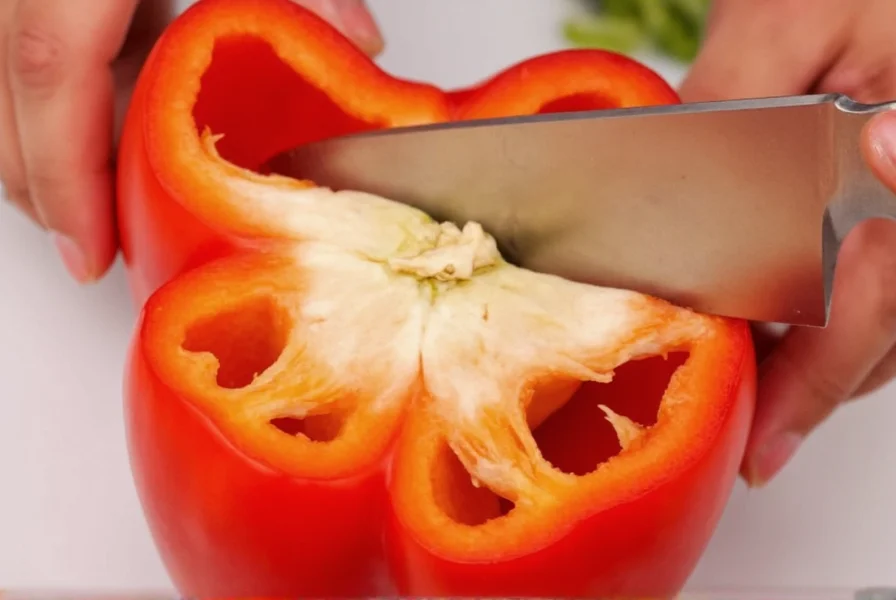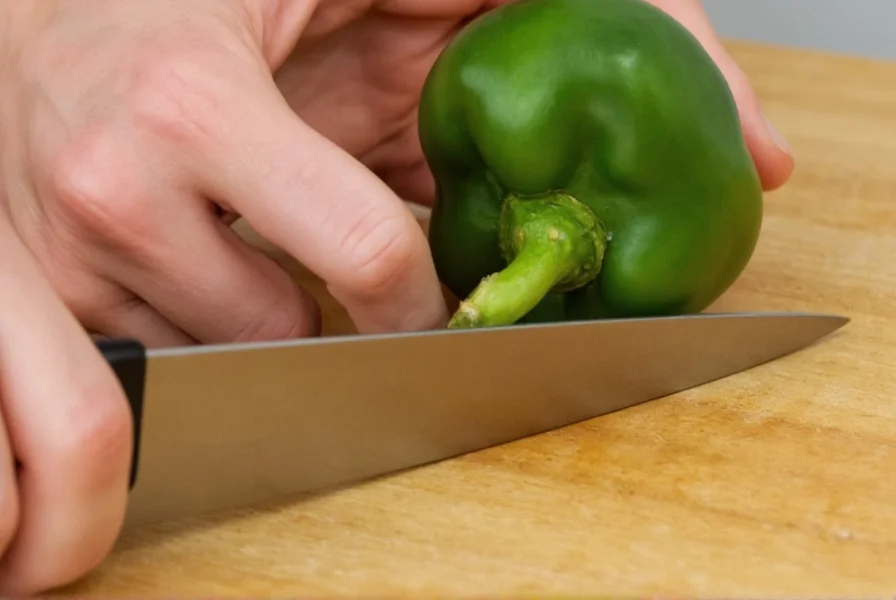The safest and most efficient way to cut a pepper involves four key steps: wash the pepper thoroughly, cut off the top and bottom, remove the core and seeds by slicing along the white ribs, and then slice or dice according to your recipe needs. Always use a sharp chef's knife on a stable cutting board, and wear gloves when handling hot peppers to protect your skin from capsaicin oils.
Cutting peppers properly is a fundamental kitchen skill that enhances both cooking efficiency and safety. Whether you're preparing bell peppers for stir-fry, jalapeños for salsa, or poblanos for stuffed peppers, using the correct technique ensures uniform pieces, minimizes waste, and prevents accidental cuts. This guide provides professional methods trusted by culinary experts for handling all pepper varieties safely and effectively.
Essential Tools for Cutting Peppers
Before you begin, gather these kitchen essentials:
| Tool | Recommended Type | Why It Matters |
|---|---|---|
| Knife | 8-inch chef's knife | Provides control and precision for clean cuts through pepper walls |
| Cutting Board | Wood or plastic, 1.5 inches thick | Stable surface prevents slipping and protects knife edge |
| Optional | Nitrile gloves | Essential when handling hot peppers to prevent skin irritation |

Step-by-Step Pepper Cutting Technique
1. Preparation and Safety
Wash peppers under cool running water and dry thoroughly. For hot peppers like habaneros or serranos, always wear disposable gloves to prevent capsaicin transfer to your eyes or skin. Place your cutting board on a non-slip surface—dampening a kitchen towel underneath provides excellent stability.
2. Removing Top and Bottom
Position the pepper vertically on your cutting board. Using a sharp chef's knife, slice ¼ inch below the stem to remove the top. Rotate the pepper and repeat to remove the blossom end. This creates flat surfaces that prevent rolling during subsequent cuts—a crucial safety measure when learning how to cut peppers without injury.
3. Core and Seed Removal
Stand the pepper upright on one flat end. Carefully slice along the white ribs that hold the seeds, working your way around the pepper's interior. The ribs contain most of the seeds and pith. Once you've made four vertical cuts (between each 'lobe' of the pepper), the core should lift out easily. This method minimizes waste compared to traditional halving techniques.

4. Slicing and Dicing Options
For strips: Lay pepper sections flat skin-side down. Make lengthwise cuts to create julienne strips of your desired thickness. For even dice: Stack several strips, then cut crosswise at consistent intervals. Professional chefs recommend ¼-inch for salsas, ½-inch for fajitas, and 1-inch for stuffed pepper preparations. For rings: After removing top/bottom, slice horizontally through the whole pepper. Best for sandwiches or garnishes.
Special Considerations for Different Pepper Types
Bell peppers: Use the full technique above. Their thick walls benefit from precise cutting to ensure even cooking. Hot peppers (jalapeños, serranos): Work in a well-ventilated area. Never touch your face during preparation. Consider using a paper towel to hold the pepper instead of your gloved hand for extra protection when learning how to cut jalapeños without burning hands. Long peppers (banana, cubanelle): Cut lengthwise first, then lay flat for easier slicing into strips.
Common Mistakes to Avoid
- Using a dull knife - Increases slipping risk and creates uneven cuts
- Cutting while holding pepper in hand - Always use a cutting board for safety
- Removing too much flesh with seeds - Follow the white ribs for minimal waste
- Not cleaning surfaces after hot peppers - Wash all tools and surfaces with soapy water immediately
Storing Cut Peppers Properly
Place cut peppers in an airtight container with a slightly damp paper towel to maintain moisture balance. Store in the refrigerator crisper drawer for up to 5 days. For longer storage, freeze diced peppers on a baking sheet before transferring to freezer bags—this prevents clumping when you need just how to cut frozen peppers for recipes.
Frequently Asked Questions
What's the best way to remove seeds from small hot peppers?
For small hot peppers like Thai chilies, use a grapefruit spoon to scoop seeds after halving lengthwise. The curved edge reaches into narrow spaces better than regular spoons. Always wear gloves and work over the sink to contain any juice splatter when learning how to safely remove pepper seeds without burning your hands.
How can I prevent crying when cutting onions and peppers together?
Cut peppers before onions to minimize eye irritation. The compounds that make onions tear-inducing are more volatile than those in peppers. When preparing how to cut bell peppers for fajitas alongside onions, keep peppers separate until ready to use. Chilling peppers for 30 minutes before cutting also reduces vapor release.
Why does my knife slip when cutting peppers?
Knife slipping usually occurs with dull blades or wet surfaces. Ensure your chef's knife is properly sharpened—peppers' smooth skin requires a sharp edge for clean cuts. Dry both the pepper and cutting board thoroughly before starting. When learning how to cut peppers safely, use the "claw grip" with fingertips curled under to guide the knife while protecting your fingers.
Can I use a serrated knife to cut peppers?
While possible, serrated knives create ragged cuts that release more pepper oils and cause uneven cooking. A sharp 8-inch chef's knife provides cleaner cuts through pepper walls with less pressure needed. When preparing how to dice peppers evenly for salads or salsas, a straight-edge knife gives superior results and better control for precise measurements.
How do I clean my hands after handling hot peppers?
Wash hands thoroughly with soap and cold water immediately—hot water opens pores and increases capsaicin absorption. For persistent burning, rub hands with vinegar or lemon juice before washing. When learning how to cut jalapeños without burning hands, prevention is best: always wear nitrile gloves and avoid touching your face during preparation.











 浙公网安备
33010002000092号
浙公网安备
33010002000092号 浙B2-20120091-4
浙B2-20120091-4